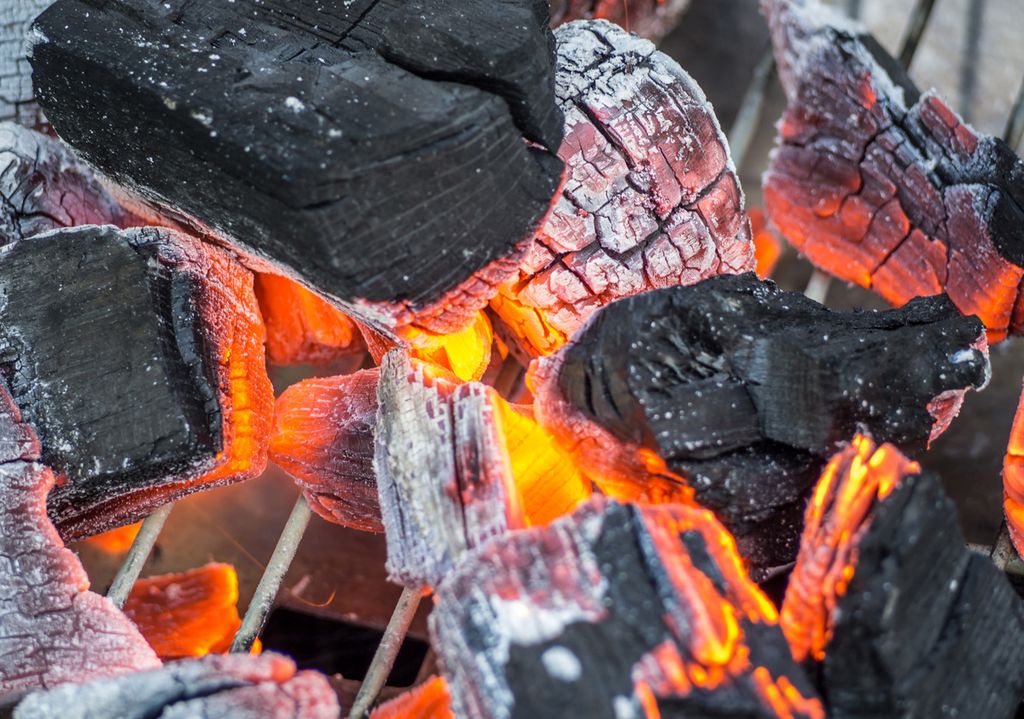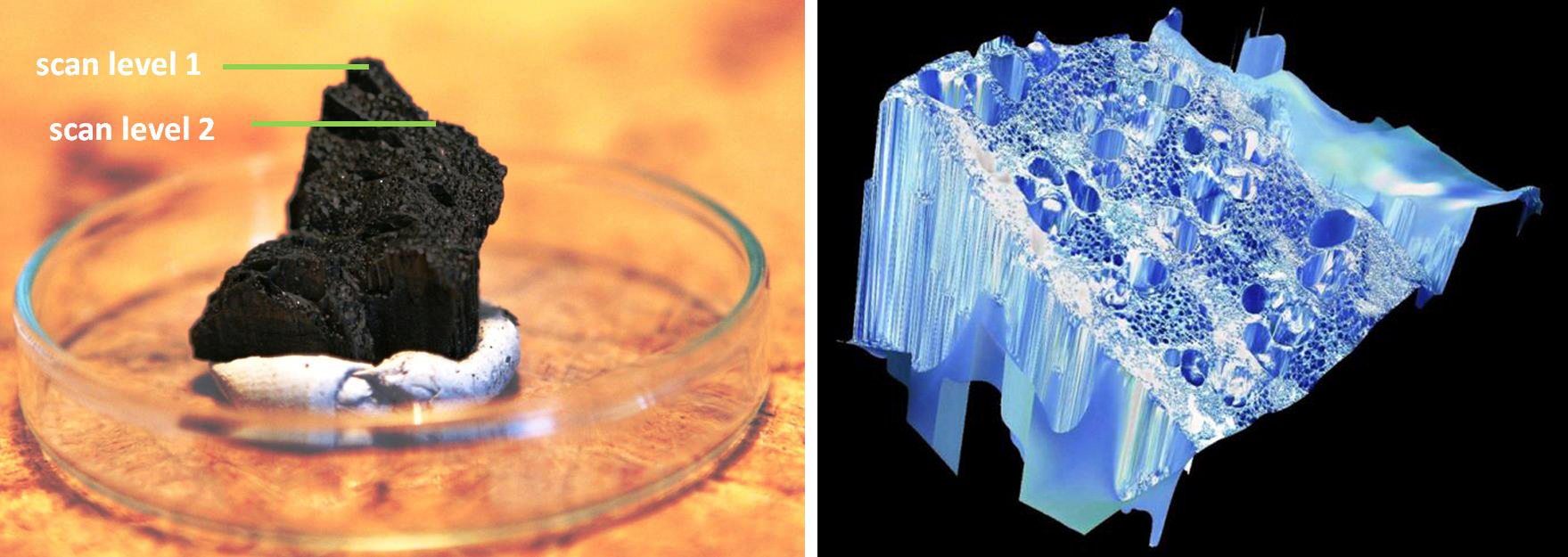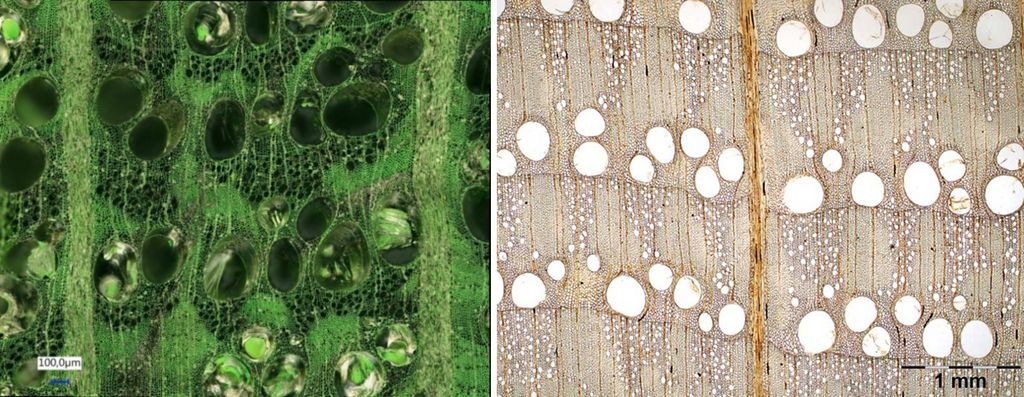Grilling with charcoal is the trend. According to figures from the German Federal Statistical Office, consumption in Germany in 2016 was 250,000 tonnes – and rising. Most of the wood used does not come from "domestic forests". Around 85 % of the sold charcoal is imported from abroad, often from tropical and subtropical regions, but also from Eastern European forests.
New microscopy method
Since 2016, several consumer and environmental protection organisations have asked the Competence Centre to test charcoal batches that are commercially available in supermarkets, petrol stations or DIY stores.
For the determination of the selected charcoal/briquette samples, a special 3D reflected light microscopy technique (Video) was used to display the characteristic anatomical structural features. In contrast to the microscopic determination of solid woods, charcoal cannot be prepared as flat (planar) cut samples, as the structure is strongly decomposed by the charring process and is very brittle. With the help of the new digital microscopy technique, the uneven areas within a programmable field are digitally scanned and assembled. This produces a three-dimensional image, which is converted into a two-dimensional representation (Fig. 1).
The quality and sharpness of the images correspond to the results obtained in the "classical" way, i.e. when preparing microscopic thin sections. The high-resolution imaging enables the detection of very small cell structures and comparison with the structural characteristics of more than 400 commercial tree species in the databases of the Thünen Institute (Figs. 2 and 3). With the help of an integrated polarisation technique, through which the images appear optically green, the contrasts of the structural features can be enhanced and native woods can be distinguished from tropical and subtropical species.
High proportion of "critical" assortments
In 2016, the Thünen Centre of Competence investigated 18 charcoal assortments from Austria. Three charcoal sacks contained admixtures of tropical woods. For another three sacks, the declarations did not match the identified woods.
Another study (20 assortments), carried out in 2017 on behalf of the WWF, revealed:
- Approximately 50 % of the assortments traded in Germany did not contain any information on the woods or tree species used,
- only 30 % of the charcoal and briquettes came from certified sources (FSC or PEFC),
- About 40 % of the assortments traded in Germany mainly contained wood from subtropical or tropical regions. Three-quarters of these consisted exclusively of tropical/subtropical woods, while in one-quarter these woods were added to woods from temperate latitudes.
Further comprehensive test orders have followed to this day. The investigantions of about 450 assortments and about 6,750 microscopically analysed individual samples have provided basic knowledge about the used woods and deviations from the declarations.
In detail, it could be stated in 2019 that about 20 % of the investigated assortments had to be assessed as "critical" with regard to the declared woods/tree species:
- Assortments which advertise the use of exclusively certain wood species ("beech wood") and in which admixtures of other "domestic woods" could be detected.
- Assortments that do not contain information on the woods used: These batches usually consist entirely of tropical/subtropical woods.
- Assortments with the declaration "from domestic hardwoods": In addition to domestic woods such as beech, maple or oak, it was also possible to detect admixtures of tropical/subtropical woods. In two cases, the batches were even FSC or PEFC certified.
In 2020, the Thünen Institute in cooperation with the WWF has carried out further investigations in a Europe-wide approach. For this purpose, 150 charcoal assortments from 11 European countries were analysed. The results are summarised in the WWF brochure "Grillkohle 2020 - Eine EU-Marktanalyse".
Charcoal from tropical wood not in any case illegal
When evaluating these results, it must be borne in mind that the use of wood from subtropical or tropical regions for the production of charcoal cannot or should not be categorised as "illegal" or "overexploitation". In Namibia, for example, woods of the genus Acacia are processed into charcoal from land maintenance measures against bushes. In many tropical regions, thinnings or residual wood from the sawmill industry are used. However, in various countries, such as Paraguay or Nigeria, the local control possibilities are very limited.
In contrast to many other wood products, charcoal is not yet subject to the EU Timber Regulation (EUTR).
It must be clearly pointed out that an exact proof of origin with genetic methods or on the basis of the isotope technology, as it is used e.g. for sawn timber, is not possible with charcoal. Therefore, the proof of a legal use/processing of wood into charcoal can only be provided by microscopic examination of the assortments as well as careful labelling and complete certification. This is demanded by NGOs and already practiced by some manufacturers.
Countries of origin:
According to the German Federal Statistical Office, around 215.000 tons of charcoal were imported into Germany in 2017. The most important supplier countries were Poland (79,000 tonnes), Paraguay (32,000 tonnes) and the Ukraine (23,000 tonnes). In 2015, 227.000 tons were imported, with Poland (74,000 tonnes) being the most important supplier country, followed by Paraguay (34,000 tonnes) and Nigeria (32,000 tonnes).
However, charcoal from Poland is not necessarily of Polish origin. Large batches of charcoal from other, e.g. African and South American countries are often mixed there and filled into sales packages. This makes traceability to the actual production country difficult.
The FAO estimates the worldwide production of charcoal at around 52 million tons per year. The main production countries (in descending order) are Brazil, Nigeria, Ethiopia, India, DR Congo, Ghana, Tanzania, China, Madagascar, Thailand (state 2015). More than 60 % of charcoal is produced in Africa – mostly under unsustainable conditions.
Seals:
The seals FSC (Forest Stewardship Council) and PEFC (Programme for the Endorsement of Forest Certification Schemes) state that the wood for the charcoal comes from sustainable forest management. Even if false declarations have been discovered in individual cases, these seals offer a high degree of security, especially since infringements are punished by the organisations (e.g. by suspending certification).
The DIN test mark (DIN EN 1860-2), on the other hand, does not make any statements on sustainability, but documents certain quality and health standards. For example, it ensures that charcoal does not contain any wood preservatives, slag, pitch or bitumen.
From wood to charcoal:
Charcoal is produced by heating wood in the absence of air and at temperatures of 200-300 °C. By-products are wood tar and pyroligneous acid. According to the FAO, about half of all trees logged worldwide are processed into "fuelwood" (firewood, charcoal, biofuels, etc.). Charcoal is produced from 17 % of the logged trees. Especially in threshold countries and developing countries charcoal is an important source of energy which is used by the local population for cooking.
As a rule, 5 to 10 tons of wood are needed to produce one ton of charcoal. With modern technology, however, it is possible to reduce consumption to 2.5 tons of wood per ton of charcoal.
Climate relevance:
Is grilling with a gas or electric grill more climate-friendly than grilling with charcoal? A life cycle assessment study by TÜV Rheinland provides a surprising answer. According to the study, the type of grilling is not as important as the selection of the barbecue food: almost 95 % of the climate-relevant emissions are caused by the food. Animal products such as beef and grilled cheese are more climate-relevant than vegetables when viewed over the entire production chain. In a life cycle assessment, emissions and other environmental impacts are mathematically analysed over the entire "life cycle" of a product.
For the analysis, the entire grilling process was considered, from the production of the individual grills and the production of the barbecue food to the grilling itself and the disposal of the barbecue appliances.
Wood species testing:
The Thünen Centre of Competence in Hamburg offers as a service the identification of woods which have been used for the production of charcoal. A special 3D reflected light microscopy technique is used for this purpose. A fee of 336 € plus VAT is charged per charcoal assortment.
Charcoal Identification with 3D-reflected light microscopy-techniques – Lecture given by Valentina Zemke, Thünen Institute of Wood Research, at the World Wood Day Symposium on March 21, 2019
Charcoal in the German media
Grillkohle-Test: Rund die Hälfte ist empfehlenswert – Öko-Test, 15.10.2020
Holzkohle mit fragwürdiger Herkunft – Spektrum der Wissenschaft, 21.09.2020
Öko-Test testet Holzkohle für den Grill: Das sind die Testsieger – Hessische/Niedersächsische Allgemeine, 11.06.2020
Die Holzdetektive – Zeitungsartikel, Rheinische Post, 19.08.2019
Holzkohle enthält oft Tropenholz: Tipps für Verbraucher – Fernsehbeitrag, ARD-Magazin „W wie Wissen“, 17.08.2019, 6:22 min. (no longer available)
Testergebnisse einer erneuten Holzkohle Analyse – Nau.ch (Schweiz) 03.07.2019
In deutschen Grills wird Tropenholz verfeuert – Zeitungsartikel, Neue Westfälische, 15.06.2019
Raubbau fürs Grillvergnügen? – Artikel über den Test von 17 Holzkohle-Sortimenten, Magazin „test“ 6/2019 der Stiftung Warentest.
Grillkohle aus Tropenholz – Fernsehsendung ZDF-Umweltmagazin „planet e“, 26.05.2019, 28 min.
FSC zertifiziert Dornenbüsche in Namibia für die Herstellung von Holzkohle – Pressemitteilung des FSC, 23.05.2019
FSC sorgt für saubere Holzkohle – Artikel von FSC Deutschland, 22.05.2019
Klimakiller Holzkohle – Fernsehsendung 3sat, 12.12.2018, 44 min. (nicht mehr in der Mediathek)
Das schmutzige Geschäft mit der Grillkohle – Fernsehsendung ARD, 03.07.2018, 44 min. (nicht mehr in der Mediathek)
Arglose Grill-Fans verfeuern Tropenholz – Zeitungsartikel, Badische Neueste Nachrichten, 03.07.2018 (no longer available)
Tropenholz landet als Holzkohle in deutschen Grills – Zeitungsartikel, Neue Osnabrücker Zeitung, 10.04.2018
Grillkohle aus Tropenholz – Fernsehbeitrag ZDF-Magazin „frontal 21“, 22.08.2017, 7 min.
Tropenholz in Grillkohle entdeckt – Fernsehbeitrag NDR-Magazin „panorama 3“, 22.08.2017, 7 min.




